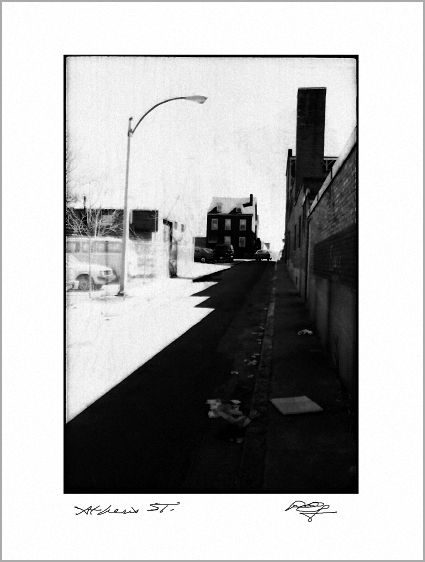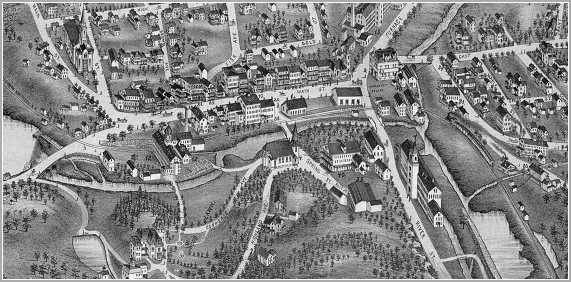Helped by the style of its Second Empire mansard roof, the high ceilings of the parlor and halls are an opportunity to do justice to large landscape prints in my ca 1862 home in Stafford Springs. (see previous post) That’s an appropriate time frame too for I like my art to be wide open in understanding its precedents, especially the Hudson River School, America’s home-grown visual definition of a unique heritage. Amidst the portrayal of a sublime wilderness we see a pasture, cows, a cabin, a mill, perhaps the turret of a Victorian mansion. From the watershed at the Massachusetts state line, the Middle River becomes the Willimantic in the center of town, and recently I had occasion to leisurely drive state road #32 south along the river, further where it joins the Natchaug to form the Shetucket, continuing and then over a height of land to the Nantic River only to again meet up with the Shetucket at the headwaters of the Thames River, an estuary to Long Island Sound. Norwich Free Academy was founded in 1854 as privately endowed to be independent of political pressure and including the betterment of youth from the surrounding towns. The associated 1886 Slater Memorial Museum, a gift from a resident scion of “The Birthplace of the American Industrial Revolution”, now the historic site in Pawtucket, Rhode Island, also provides art classes. A new multi-story glass atrium allows close eyeball of the magnificent Richardsonian Romanesque building. I was there to deliver a couple framed prints for consideration in their 72nd Annual Connecticut Artists Exhibition. But the really special treat I found in one of the upper galleries, wonderful works by a second generation local member of that esteemed School of artists, John Denison Crocker. I did not know him. Mills fit comfortably within a bucolic panorama of the port and rolling hillsides. Especially enthralling was The Capture of Miantonomo, painted in 1847, and a bequest of William A. Slater.

Slater Memorial Museum
The Thames had been known as the Pequot River, but after the 1636 war, the defeated remnant of the tribe no longer had control as frictions rose between the now neighboring Narragansett and Mohegan. Both enemies of the dominant Pequots they had allied in that war with the English in Boston. But the Puritans had been welcomed to some Mohegan lands along the Connecticut, whereas the Narragansett had friendly relations with Roger Williams of Providence Plantations whose beliefs in religious tolerance and Native rights were an anathema. In July of 1643, when the Sachem Uncas got word of Sachem Miantonomo’s secret approach on the Mohegan Fort Shantok he met him instead on the “Sachem Plains” west of the Shetucket. A surprise attack split the Narragansetts, some escaped by immediately forging the river, while others including Miantonomo were first pursued west toward Nantic Falls gorge. Now, while how and whoever actually leapt over the gorge, or fell, depends on the version of the story being told, the chase continued, Miantonomo was captured and brought to Hartford to await the disposition of the English. It happened that the United Colonies of New England, excluding Providence, were actually holding their first meeting, and without any examination of the allegations precipitating the confrontation, the decision was that Uncas could not be safe with Miantonomo alive so they ordered that he be killed on Mohegan lands, also ensuring the two powerful tribes would never unite against them. Miantonomo was buried on Sachem’s Plain at the place traditionally where he had been captured.
Today there’s a small monument erected in 1841 to Mianomoto almost lost on Elijah Street near the Shetucket in the middle of a small mid-twentieth century neighborhood perhaps near to where he is buried, but not far from what is now Unca’s Leap at the Yantic Falls and a more impressive obelisk to Uncas found nearby on Sachem Street. Here at the head of the estuary Norwich is seeking proposals funded by a state brownfield initiative for environmental and archeological study of the falls, the leap, and some granite and brick mills from their gilded age. The Mohegan Sun Casino is a few miles south on the Thames with the Mashantucket Pequot’s Foxwoods not far to the east. The CT/RI state line follows roughly the former extent of the Narragansett domain.
I hope those with a larger stake can appreciate this novice attempt at relevance, and thank you Slater for including Goldenrod from my Reimagine New England suite in the Connecticut exhibition. The museum truly is “a local gem” with an ambiance of Victorian sensibilities.
 River Road looking south in South Willington, CT
River Road looking south in South Willington, CT













